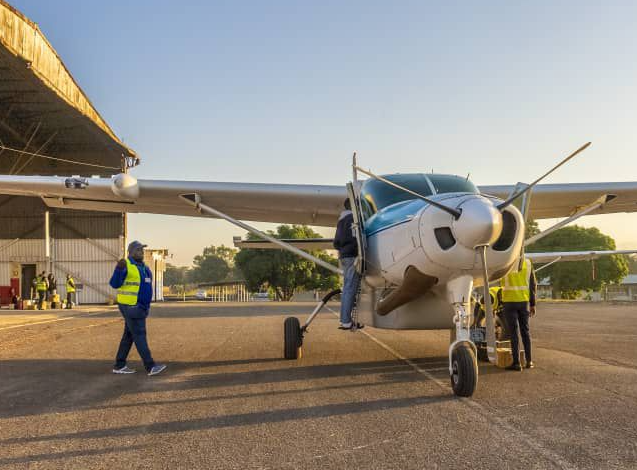
No 1B at Zuze Airforce Base, Ndola



From inception, ZFDS has been providing aeromedical services in rural and hard-to-reach areas of the country. However, the absence of land-able airstrips in most parts of the country has over the years been limiting the Service’s ambition to take health services as close to the people as possible.
The goal of ZFDS is to increase access to aeromedical services in hard-to-reach areas and strengthen the referral system from low-level to high-level hospitals in order to reduce morbidity and mortality among the people of Zambia.
ZFDS is the only civil aviation wing of the government that provides aeromedical services to hard-to-reach remote areas. Additionally, it carries out referral services from low-level hospitals to high-level hospitals within the country. The responsibility and ambition to provide an efficient and effective service is hampered by the institution’s lack of all-weather aircraft, thereby requiring the services of a helicopter to bridge the gap in access to health care.

The Service has no helicopters, making it difficult to be fully involved in emergency evacuations and disasters that occur in areas where there are no airstrips.
With approximately 61% of Zambia’s population living in rural areas, ensuring access to services in rural areas is central to achieving national health goals. Zambia suffers from a national human resources for health (HRH) shortage, with 11.2 doctors, nurses, and midwives per 10,000 persons, which is well below the WHO minimum recommended threshold of 22.8 doctors, nurses, and midwives per 10,000 persons. As of 2017, approximately 10% of Zambia’s health workforce was lost each year to attrition. Although there has been an overall increase in the number of clinical health workers since 2008, shortages remain highest in rural areas. While the majority of Zambia’s population lives in rural areas, the total number of doctors, nurses, and midwives in rural areas stands at 7,677 compared to 9,285 in urban areas. An analysis of the workforce in 2016 showed that 45% of doctors, clinical officers, nurses, and midwives were working in rural areas.
The above creates a gap in the ability to access medical services, let alone emergency medical services. Most communities are unable to get quick medical services, as most roads are impassable using motor transportation. The proximity to health facilities also greatly contributes to the increase in mortality rates related to diseases that can be easily treated.
Hence procurement of helicopters for ZFDS would be a mitigating factor with a well-coordinated system in collaboration with RATSA, and other stakeholders and in turn reduce loss of life through road traffic accidents. The purchase of an Air Bus Helicopter-H 135 will allow ZFDS to be able to respond to all emergency evacuations within the shortest period of time without any land-ability concerns. This will ensure that the communities we serve are able to access healthcare services from any facility within the country irrespective of location. The Air Bus Helicopter-H 135 has a capacity of up to seven (7) passengers and one (1) pilot allowing us to ferry enough medical personnel to attend to the patient.
Emergencies born out of motor accidents and work-related accidents, especially for workers found in construction sites and mining sites, are high. For instance, during the year 2021, a total number of 32,372 road traffic accidents were recorded countrywide, of which 1,757 were fatal with 1,163 persons killed. There were 2,988 serious road traffic accidents, with 5,307 persons seriously injured. Additionally, there were 6,231 slight road traffic accidents, in which 9,182 persons were slightly injured, and 21,396 were recorded as damage-only road traffic accidents.

With an efficient system of ferrying medical staff to accident scenes in the quickest possible time, the number of fatalities could drastically reduce. Hence, the procurement of helicopters for ZFDS would be a mitigating factor with a well-coordinated system in collaboration with RATSA and other stakeholders, reducing loss of life through road traffic accidents.
The purchase of an Airbus Helicopter H-135 will allow ZFDS to respond to all emergency evacuations within the shortest period of time without any land-ability concerns. This will ensure that the communities we serve can access healthcare services from any facility within the country, irrespective of location. The Airbus Helicopter H-135 has a capacity of up to seven passengers and one pilot, allowing us to ferry enough medical personnel to attend to the patient.
The estimated cost of a brand-new helicopter is in the range of $6.3 million, while a second-hand helicopter costs between $2.5 million to $5 million. Furthermore, ten percent of the cost of the aircraft will be needed for aircraft spares, specific equipment such as aircraft jacks, hydraulic rigs, and pilots' and engineers' training.
To adequately and efficiently operate these new aircraft, pilots will need to undertake conversion training, while helicopter engineers will undertake manufacturer’s training in airframes. On engines, ZFDS engineers already have the manufacturer’s training and only require a rating endorsement on their licenses after sitting for an examination from the local Civil Aviation Authority.